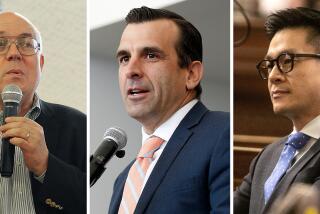O.C. to Put Scantrons to the Test
- Share via
Unwilling to rely on old punch-card machines and not yet ready to use new technology to tally ballots in California’s first gubernatorial recall election, the Orange County registrar of voters instead will opt for something even grade-school students are familiar with: Scantron forms.
The forms, made by Irvine-based Scantron Corp., require voters to choose their candidate by filling in a rectangular space with an indelible black pen. The forms are then run through a machine that tallies the votes.
For the record:
12:00 a.m. Aug. 15, 2003 For The Record
Los Angeles Times Friday August 15, 2003 Home Edition Main News Part A Page 2 National Desk 1 inches; 54 words Type of Material: Correction
Orange County ballot -- An article in the California section of the Orange County Edition on Thursday incorrectly reported that ballots to be used for the recall election in Orange County are made by Irvine-based Scantron Corp. The ballots, which resemble forms produced by Scantron, will be made by Hart Intercivic of Austin, Texas.
In past elections, the county has relied on antiquated punch-card ballots. In April, Orange County decided to switch to a $26.1-million electronic voting system. The new system, called eSlateTM, was bought as part of a nationwide campaign to upgrade local voting systems after the controversy over the Florida presidential vote in 2000.
But poll workers are not familiar with the machines, and with a potentially messy recall election looming Oct. 7, the registrar did not believe this was the time to introduce a new technology.
“We simply don’t have enough time to train all the poll workers before the election,” said Interim Registrar of Voters Steve Rodermund. “[With Scantron], we can put all of the names on one sheet, front and back. It makes it much more doable for everyone.”
Rodermund calls the Scantron system “exceedingly accurate” and said voters would be comfortable using it.
“When you’re talking several hundred thousand people voting, there’s always a chance someone’s going to be confused,” he said. “But this is a marking system that people have been using since the second grade. I think we’ll be fine.”
Less clear is how the recall election, expected to cost the county $1.5 million to $2 million, will be financed. The Orange County Board of Supervisors has already approved funding for the March primary, expected to cost more than $2 million, Rodermund said. Money for the recall will be taken from that pot, leaving it nearly empty for the primary. Sometime this year, supervisors will have to figure out where to get the money for the March election.
Supervisor Tom Wilson said finance officials might dip into the county’s reserves. But there are no specifics as to how the county will ultimately absorb the cost. “It’s not going to be easy,” Wilson said. “We’ve already made draconian cuts to our budget.”
The registrar is still ironing out the details of how the recall votes will be counted. To make the ballot-counting faster, the county is weighing bringing in more than five Scantron machines and possibly collecting ballots from precincts midway through election day.
The registrar has also been gearing up by trying to quickly recruit poll workers. Community outreach and enhanced poll worker training has been a priority for the county since it came under fire for problems during the 2000 general election. In that election, 40,000 sample ballots were shipped late to Spanish- and Vietnamese-speaking voters, a Libertarian candidate was misidentified as a Republican on the ballot and a precinct opened without any ballots.
Poll workers receive a $50 to $70 stipend for a 16-hour day. About 7,000 volunteers work at the county’s 1,716 precincts on a typical election day. For the recall election, the county will need 2,500 poll workers for 459 precincts, Rodermund said.
About 400 of the precincts will require bilingual poll workers, prompting the county to make an effort to recruit workers who can speak Spanish, Vietnamese, Chinese or Korean. The registrar is hoping those workers can help voters understand a potentially confusing election.
“We have a consolidated election here, so there are going to be a number of people who will need to understand that they may not be going to the same polling place they went to in the last election,” said Dennis White, supervisor for community outreach.
Training for poll workers is expected to take longer than usual, White said, but county officials want to make sure workers can help voters and make them feel confident that their vote will count.
“It’s going to require educating people, even ourselves, on how this is all going to work, and it’s going to involve a lot of fast communication,” White said. “The time frame is so compressed that it makes things a little harder, but it’s a matter of stepping up to the challenge.”
*
(BEGIN TEXT OF INFOBOX)
Election tab
Estimates of the total cost of the recall election to California counties range from $42.16 million to $55.59 million. Los Angeles County has the highest estimated cost.
(in millions of dollars)
Los Angeles Co. -- $12-$20
San Diego Co. -- $3-$3.5
Alameda Co. -- $1.5-$2
Orange Co. -- $1.5-$2
Contra Costa Co. -- $1.45-$1.65
Fresno Co. -- $1.5
San Bernardino Co. -- $1-$1.5
Riverside Co. -- $1
Ventura Co. -- $0.8
Source: California Secretary of State -- Researched by Times reporter Lois Hooker
*
Times staff writer David Reyes contributed to this report.
More to Read
Get the L.A. Times Politics newsletter
Deeply reported insights into legislation, politics and policy from Sacramento, Washington and beyond. In your inbox twice per week.
You may occasionally receive promotional content from the Los Angeles Times.










